Partial Phase Image Sequence
When I was preparing for 2001 I was determined to do the complete sequence of the eclipse just like Fred Espenak had published many times. When I really started to concentrate on how to do, it I realized it takes some thought.
1. You have to decide how many partial phase images you want to frame totality, before and after, 4, 6, 8, 10 images?
2. You have to realize that taking a image RIGHT at C1 doesn't show anything but the full Sun disk because there has been no time for the Moon to take a bite out of the Sun. Same thing is true for RIGHT at C4.
3. You want to finish your last partial phase image in advance of C2 because you want to be preparing for your diamond ring and Baley's beads imaging.
4. The last few minutes before totality is completely overwhelming! The effect around you, as the lighting changes, is SO exciting. If you are in a natural environment, like a field, the crickets will be chirping like crazy because they think night is coming. You have to take time to enjoy this short and wonderful period of time, but also concentrate on your photography plan.
5. Depending on your observing position the time span between C1 and C2 is different than the time span between C3 and C4. It is the most equal at the point of greatest eclipse and as you get further away from that point the difference gets greater.
6. Most casual observers are excited to know when C1 happens, they may take an image or two afterward and then most people are going to be milling around talking and relaxing waiting for totality. They are going to distract you and you have to concentrate on your timing for the shots.
7. Everything I said in #6 above is 100 times worse after C3! It takes a lot of determination on your part to stay at your gear for over another hour (in the heat), after C3 when everyone else wants to party! You will be distracted! Almost no one is willing to take the second set of images.
8. The closest crescent to either side of totality may have to have one shutter speed slower, because it starts to get dim
9. You have to be lucky to have clear skies for over 3 hours!
10. The math, to get the clock times for the sequence, is certainly doable for smart astronomers like you, but it's just a pain in the butt. I've done it manually 2 times.
11. My app is the only app in the world, that I know of, that will do the calculations automatically for you with one tap.
In 2001 and 2002 I did a sequence of 8 shots. The timing was not always right on the mark because of getting distracted (#4, #6 and #7 above).
For 2017 I have done the automatic calculation with 10 images before totality and 10 images after.
I had to choose a time to take the 1st image and the 20th image. I chose to do it 120 seconds after C1 and 120 seconds before C4. Again, this was chosen so you can definitely see a bit out of the Sun by the Moon. I chose to take the final image before C2 at 120 seconds before, so you can switch gears and get ready for totality, and therefore, to make things even, I have an image 120 seconds after C3.
So you can see from the slide from my eclipse photography talk, you have to take the time from C1 to C2 and subtract 240 seconds, then divide that time to get the gaps for your images and then add the minutes and seconds back to the time that is 120 seconds after C1. Do that clock time addition 10 times. Then if you are far away from greatest eclipse point, you have to do it all again for the time between C3 and C4.
So you could have this all organized, in advance, for your pre-planned observing position. But if, the day before, or the day of the eclipse, you have to change your position, the partial phase times will change a little. Not much, but some, and it just depends on how compulsive you want to be regarding doing the math again.
On my website I have a PDF file that can be downloaded, so you can write all of your times down. It is called the PPISC Worksheet. It also has helpful tips about the entire photography plan right on it.
Download the PPISC Worksheet
Partial Phase Image Sequence
When I was preparing for 2001 I was determined to do the complete sequence of the eclipse just like Fred Espenak had published many times. When I really started to concentrate on how to do, it I realized it takes some thought.
1. You have to decide how many partial phase images you want to frame totality, before and after, 4, 6, 8, 10 images?
2. You have to realize that taking a image RIGHT at C1 doesn't show anything but the full Sun disk because there has been no time for the Moon to take a bite out of the Sun. Same thing is true for RIGHT at C4.
3. You want to finish your last partial phase image in advance of C2 because you want to be preparing for your diamond ring and Baley's beads imaging.
4. The last few minutes before totality is completely overwhelming! The effect around you, as the lighting changes, is SO exciting. If you are in a natural environment, like a field, the crickets will be chirping like crazy because they think night is coming. You have to take time to enjoy this short and wonderful period of time, but also concentrate on your photography plan.
5. Depending on your observing position the time span between C1 and C2 is different than the time span between C3 and C4. It is the most equal at the point of greatest eclipse and as you get further away from that point the difference gets greater.
6. Most casual observers are excited to know when C1 happens, they may take an image or two afterward and then most people are going to be milling around talking and relaxing waiting for totality. They are going to distract you and you have to concentrate on your timing for the shots.
7. Everything I said in #6 above is 100 times worse after C3! It takes a lot of determination on your part to stay at your gear for over another hour (in the heat), after C3 when everyone else wants to party! You will be distracted! Almost no one is willing to take the second set of images.
8. The closest crescent to either side of totality may have to have one shutter speed slower, because it starts to get dim
9. You have to be lucky to have clear skies for over 3 hours!
10. The math, to get the clock times for the sequence, is certainly doable for smart astronomers like you, but it's just a pain in the butt. I've done it manually 2 times.
11. My app is the only app in the world, that I know of, that will do the calculations automatically for you with one tap.
In 2001 and 2002 I did a sequence of 8 shots. The timing was not always right on the mark because of getting distracted (#4, #6 and #7 above).
For 2017 I have done the automatic calculation with 10 images before totality and 10 images after.
I had to choose a time to take the 1st image and the 20th image. I chose to do it 120 seconds after C1 and 120 seconds before C4. Again, this was chosen so you can definitely see a bit out of the Sun by the Moon. I chose to take the final image before C2 at 120 seconds before, so you can switch gears and get ready for totality, and therefore, to make things even, I have an image 120 seconds after C3.
So you can see from the slide from my eclipse photography talk, you have to take the time from C1 to C2 and subtract 240 seconds, then divide that time to get the gaps for your images and then add the minutes and seconds back to the time that is 120 seconds after C1. Do that clock time addition 10 times. Then if you are far away from greatest eclipse point, you have to do it all again for the time between C3 and C4.
So you could have this all organized, in advance, for your pre-planned observing position. But if, the day before, or the day of the eclipse, you have to change your position, the partial phase times will change a little. Not much, but some, and it just depends on how compulsive you want to be regarding doing the math again.
On my website I have a PDF file that can be downloaded, so you can write all of your times down. It is called the PPISC Worksheet. It also has helpful tips about the entire photography plan right on it.
Download the PPISC Worksheet
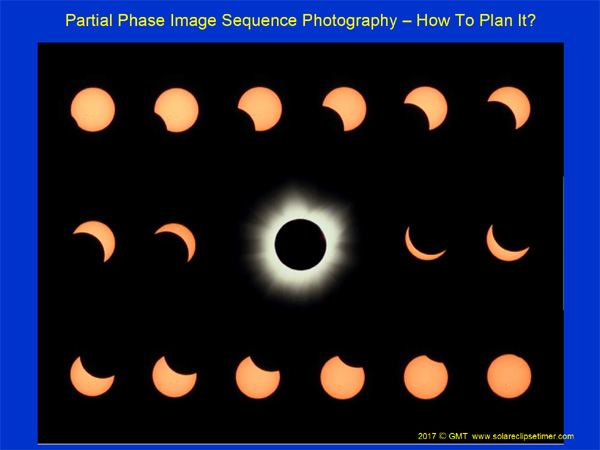
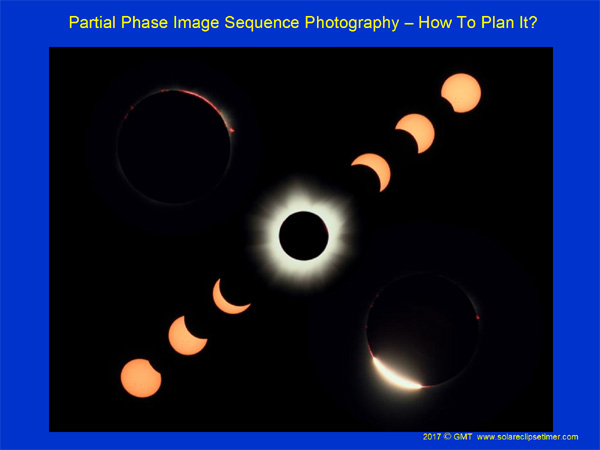
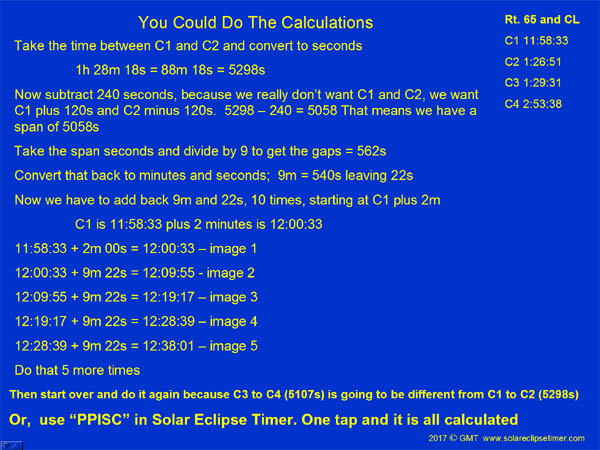
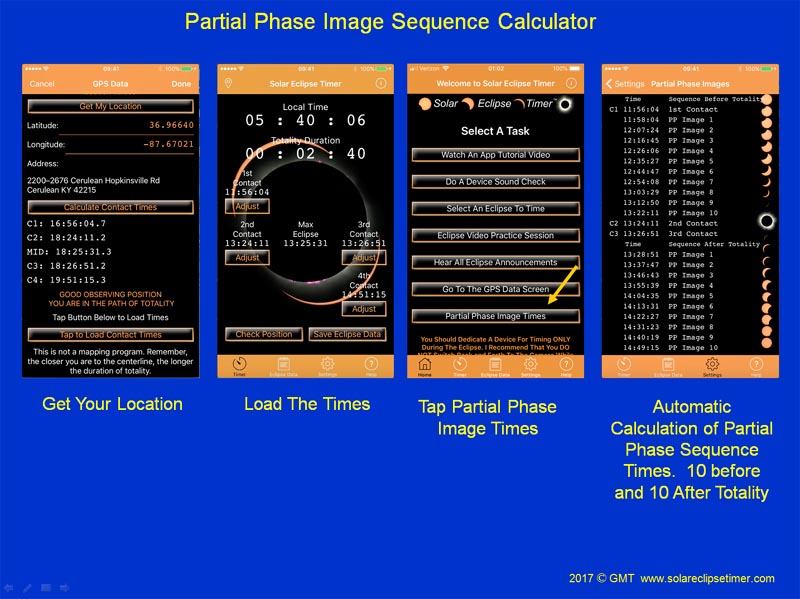
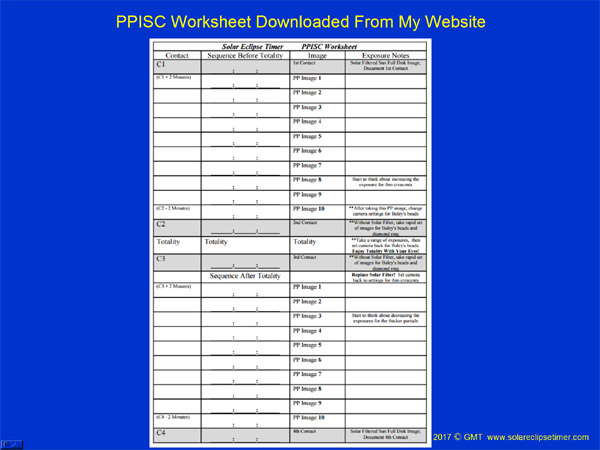
Copyright 2002 - 2019 Gordon Telepun and Foxwood Astronomy, LLC
Solar Eclipse Timer and the Solar Eclipse Timer logos are Resistered Trademarks of Gordon Telepun.
The Solar Eclipse Timer banner art and all other art related to the Solar Eclipse Timer website and mobile applications are protected by copyright.